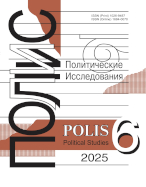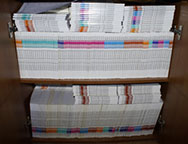Centers of power in world politics:
diversifying leadership resources
Semenenko I.S.,
Primakov National Research Institute of World Economy and International Relations, Russian Academy of Sciences, Moscow, Russia, semenenko@imemo.ru
elibrary_id: 251670 | ORCID: 0000-0003-2529-9283 |
Lapkin V.V.,
Primakov National Research Institute of World Economy and International Relations, Russian Academy of Sciences, Moscow, Russia, vvlh@politstudies.ru
elibrary_id: 43429 | ORCID: 0000-0002-0775-2630 | RESEARCHER_ID: AAB-9386-2021
Pantin V.I.,
Primakov National Research Institute of World Economy and International Relations, Russian Academy of Sciences, Moscow, Russia, v.pantin@mail.ru
elibrary_id: 74145 | ORCID: 0000-0002-4218-4579 | RESEARCHER_ID: K-5736-2017
Article received: 2025.05.18 16:00. Accepted: 2025.06.20 16:00

DOI: 10.17976/jpps/2025.05.08
EDN: EBTYSJ
Semenenko I.S., Lapkin V.V., Pantin V.I. Centers of power in world politics: diversifying leadership resources. – Polis. Political Studies. 2025. No. 5. https://doi.org/10.17976/jpps/2025.05.08. EDN: EBTYSJ (In Russ.)
This article was prepared with the support of a grant from the Ministry of Science and Higher Education of the Russian Federation for major scientific projects in priority areas of scientific and technological development No. 075-15-2024-551 “Global and regional centers of power in the emerging world order”.
The emerging new world order is based on an evolving balance of power, and this is a strong incentive to reconsider the potential of the key actors of these transformations that aspire to the status of “centers of power”. In international political studies, these entities are usually presented as global (world) and regional powers. The article aims to verify and develop this classifcation, and to characterize the resources these actors rely on in an increasingly turbulent world. The authors formulate criteria characterizing “centers of power” in the emerging world order and clarify the substantive characteristics of this concept. We assess the current mechanisms for strengthening the leadership positions of centers of power in times when competition for development resources grows and international political conflicts intensify, and offer an expansive interpretation of the concept of “center of power”, which are not limited to sovereign “powers” within the borders of a nation-state. In a comparative perspective, world politics are presented as a systemic dynamic of conjugate centers of power and as a multitude of poles of world development. Special attention is paid to the study of the systemic organization of the polycentric world order, structured by centers of power, and to the target-oriented orders they generate. Examples of power centers in the modern world order, varying in influence, in the nature of their claims to leadership and in resource provision, include the USA, China, India, Australia and the Turkic world currently centered on Turkey. The discursive power of such centers has important ideological and political dimensions. The potential for strengthening Russia's position as a global center of power is assessed in this regard. Leadership positions of emerging centers of power are afrmed via the diversifcation of their resource potential, and values-oriented political projects based on the civilizational foundations of the identity of large political communities are a key instrument to this end. Promoting a new paradigmatic basis for global development capable of providing a diversity of political space dimensions to uphold a polycentric world order is high on the agenda of world politics.
References
Abbondanza, G. (2020). Middle powers and great powers through history: the concept from ancient times to the present day. History of Political Thought, 41(3), 397-418.
Abbondanza, G., & Wilkins, T.S. (Eds.). (2021). Awkward powers: escaping traditional great and middle power theory. Basingstoke: Palgrave Macmillan. https://doi.org/10.1007/978-981-16-0370-9
Barnett, M., & Duvall, R. (2005). Power in International Politics. International Organization, 59, 39-75. https://doi.org/10.1017/S0020818305050010
Beckley, M. (2018). The power of nations: measuring what matters. International Security, 43(2), 7-44. https://doi.org/10.1162/isec_a_00328
Berenskoetter, F., Williams, M.J. (Eds.). (2008). Power in world politics. London; New York: Routledge.
Bhabha, H.K. (1994). The location of culture. London, Routledge.
Buttorff, G.J. (2018). Centers of power, regime strength, and opposition beliefs. In G.J. Buttorff, Authoritarian Elections and Opposition Groups in the Arab World (pp. 57-89). Cham: Palgrave Macmillan. https://doi.org/10.1007/978-3-319-92186-0_4
Buzan, B., & Wæver, O. (2003). Regions and powers. The structure of international security. Cambridge: Cambridge University Press.
Garzón, J. (2017). Multipolarity and the future of economic regionalism. International Theory: A Journal of International Politics, Law and Philosophy, 9(1), 101-135. https://doi.org/10.1017/S1752971916000191
Haas, R.A. (2017). World in disarray: American foreign policy and the crisis of the old order. New York: Penguin Press.
Hall, S. (1991). Old and new identities, old and new ethnicities. In A.D. King (Ed.), Culture, Globalization and the World System (pp. 41-68). London: Macmillan. https://doi.org/10.1007/978-1-349-11902-8_2
Hoekman, B. (2014). Sustaining multilateral trade cooperation in amultipolar world economy. The Review of International Organizations, 9(2), 241-260. https://doi.org/10.1007/s11558-014-9187-3
Ikenberry, J. (Ed.). (2002). America unrivaled: the future of the balance of power. Ithaka; London: Cornell University Press.
Jiang, Shiwei, & Baig, Tasawar (2013). Is bipolarity a sound recipe for world order – as compared to other historically known alternatives? In ICD Annual Conference on Cultural Diplomacy in the USA “Options on the Table”, Soft Power, Intercultural Dialogue & the Future of US Foreign Policy. https://www.culturaldiplomacy.org/academy/ content/pdf/participant-papers/2013-acdusa/Is-Bipolarity-a-sound-recipe-for-world-order-Shiwei-Jiang.pdf
Khanna, P. (2008). The Second World: empires and influence in the new global order. New York: Random House Publishing Group.
Layne, C. (1993). The unipolar illusion: why new great powers will rise? International Security, 17(4), 5-51. https://doi.org/10.2307/2539020
Lesh, M. (2018). Democracy in a divided Australia. Brisbane: Connor Court.
Little, R. (2007). The balance of power in international relations: metaphors, myths, and models. Cambridge: Cambridge University Press.
Mansfield, E.D. (1993). Concentration, polarity, and the distribution of power. International Studies Quarterly, 37(1), 105-128. https://doi.org/10.2307/2600833
Mead, W.R. (2005). Power, terror, peace, and war: America’s grand strategy in a world at risk. New York: Vintage Books.
Nossel, S. (2004). Smart power. Foreign Affairs, 83(2), 131-142. https://doi.org/10.2307/20033907
Nye, J.Jr. (2004). Soft power: the means to success in world politics. New York: PublicAffairs Books.
Nye, J.Jr. (2018). How sharp power threatens soft power. Foreign Affairs. https://www.foreignaffairs.com/articles/china/2018-01-24/how-sharp-power-threatens-soft-power
Olson, M. (2000). Power and prosperity: outgrowing communist and capitalist dictatorships. New York: Basic Books.
Ozsaglam, M.T. (2019). Complicated multipolar international relations system: Russia and China as new power centers! Business and Economics Research Journal, 10(3), 749-760. https://doi.org/10.20409/berj.2019.198.
Posen, B.R. (2011). From unipolarity to multipolarity: transition in sight? In G.J. Ikenberry, M.l. Mastanduno, & W.C. Wohlforth (Eds.), International Relations Theory and the Consequences of Unipolarity (pp. 317-341). Cambridge: Cambridge University Press. https://doi.org/10.1017/CBO9780511996337.010
Røren, P. (2024). Unipolarity is not over yet. Global Studies Quarterly, 4(2), ksae018. https://doi.org/10.1093/isagsq/ksae018
Roumate, F. (2022). AI and international relations: a new balance of power in a new world order. Communications. Media. Design, 7(1), 23-33.
Said, E.W. (1979). Orientalism. New York: Knopf Doubleday; Vintage Books.
Schweller, R. (2016). The balance of power in world politics. In Oxford Research Encyclopedia of Politics. Oxford: Oxford University Press. https://doi.org/10.1093/acrefore/9780190228637.013.119
Wang, Ch. (2024). A study of soft power rankings: concepts, method(ology), and evaluation. In N. Chitty, L. Ji, & G. Rawnsley (Eds.), The Routledge Handbook of Soft Power (pp. 190-211). London; New York: Routledge. https://doi.org/10.4324/9781003189756-14
Weiwei, Zh. (2012). The China wave: rise of a civilizational state. Hackensack: World Century Publishing Corporation. https://doi.org/10.1142/u001
Wild, D., Gorman, Z., & Bushnell, A. (2019). Australian values and the enduring importance of the nation-state. Melbourne: Institute of Public Affairs.
Wohlforth, W.C. (1999). The stability of a unipolar world. International Security, 24(1), 5-41. https://doi.org/10.1162/016228899560031
Wohlforth, W.C. (2022). Polarity and international order: past and future. In N. Græger, B. Heurlin, O. Wæver, & A. Wivel (Eds.), Polarity in International Relations, Governance, Security and Development (pp. 411-424). Cham: Palgrave Macmillan; Springer. https://doi.org/10.1007/978-3-031-05505-8_21
Baranovsky, V.G. (2019). New international order: overcoming or transforming the existing pattern? World Economy and International Relations, 63(5), 7-23. (In Russ.) https://doi.org/10.20542/0131-2227-2019-63-5-7-23
Baranovsky, V.G. (2025). On the formation of a new world order. Polis. Political Studies, 1, 7-23. (In Russ.) https://doi.org/10.17976/jpps/2025.01.02
Batalov E. (2003). “New world order”: to the methodology of analysis. Polis. Political Studies, 5, 25-37. (In Russ.)
Bogaturov A.D. (1997). Great powers on the Pacific Ocean. History and theory of international relations in East Asia (1945-1995)]. Moscow: Konvert – MONF.
Borokh, O.N., & Lomanov, A.V. (2024). Productive forces and Chinese relations. Russia in Global Affairs, 22(5), 120-141. (In Russ.) https://doi.org/10.31278/1810-6439-2024-22-5-120-141
Degterev, D.A. (2024). The major types of power in the international arena: structural power, power of interdependence, “hard” and “soft” power. Russia & World: Scientific Dialogue, 4(14), 20-33. (In Russ.) https://doi.org/10.53658/RW2024-4-4(14)-20-33
Degterev, D.A., & Khudaykulova, A.V. (2018). Balance of power in international political science: theoretical concepts and applied analysis. National Security / Nota Bene, 1, 1-12. (In Russ.) https://doi.org/10.7256/2454-0668.2018.1.25193
Dynkin A. (Ed.). (2017). World 2035. Global Forecast. Moscow: Magistr Publishers. (In Russ.)
Dynkin, A., & Ivanova N. (Eds.). (2011). Россия в полицентричном мире [Russia in the polycentric world]. Moscow: Ves’ Mir publishing house. (In Russ.)
Dynkin, A., & Ivanova N. (Eds.). (2014). Globalnaya perestroika [Global perestroika]. Moscow: Ves Mir. (In Russ.)
Frolov, A.V. (2016). “Centers of power” and multipolarity: a view through time. Mezdunarodnaa ziznʹ, 11, 106-121. (In Russ.)
Gantman, V.I., & Primakov, E.M. (2022). Main features of the system of international (interstate) relations. In N.N. Inozemtsev (Ed.), The Fundamentals of the Theory of International Relations: The Experience of IMEMO in the 1970s (pp. 193-242). Moscow: Aspect Press. (In Russ.)
Gorbunova, M.L., & Komarov, I.D. (2020). Leading traditional and rising powers as security providers in the world most fragile states. Comparative Politics Russia, 11(3), 57-74. (In Russ.) https://doi.org/10.24411/2221-3279-2020-10036.
Hohlova, O.M., & Katunceva, A.V. (2024). Multipolarity as a structural change in the modern world. Sociologу, 8, 25-31. (In Russ.)
Inozemtsev, N.N. (Ed.). (2022). Osnovy teorii mezhdunarodnykh otnosheniy: Opyt IMEMO v 1970-ye gody [The fundamentals of the theory of the international relations: the experience of IMEMO in the 1970s]. Moscow: Aspect Press. (In Russ.)
Izotov, V.S. (2024). Greater Eurasia as a model for assembly: developing theoretical approaches. Lomonosov Political Science Journal, 4, 7-32. (In Russ.) https://doi.org/10.55959/MSU0868-4871-12-2024-2-4-00-00.
Kupriyanov, A.V. (2023). Postcolonial history in the service of anticolonial politics: critical historiography and national myth in contemporary India. Journal of International Analytics, 14(2), 35-48. (In Russ.) https://doi.org/10.46272/2587-8476-2023-14-2-35-48
Kutsenkov, A.A. (2010). Many-faced Hindutva. Vostok. Afro-aziatskie obshchestva: istoriia i sovremennost, 2, 79-94. (In Russ.)
Kuznetsov, A.V. (2022). Variety of possible centers of force in the new world order. Political Science (RU), 4, 107-120. https://doi.org/10.31249/poln/2022.04.05
Lapkin, V.V. (2017). Socio-political contexts of identity transformations in the 21st century. In I.S. Semenenko (Ed.), Identity: The Individual, Society, and Politics. An Encyclopedia (pp. 88-101). Moscow: Ves’ Mir. (In Russ.)
Lapkin, V.V. (2025). Society in development as a subject of political science. Polis. Political Studies, 2, 135-156. (In Russ.) https://doi.org/10.17976/jpps/2025.02.10
Lapkin, V.V., & Pantin, V.I. (1999). Geoeconomic politics: the subject and concepts (to the statement of the problem). Polis. Political Studies, 4, 42-59. (In Russ.)
Lapkin, V.V., & Pantin, V.I. (2004). Geoehkonomicheskaya politika i global’naya politicheskaya istoriya [Geoeconomic policy and global political history]. Moscow: Olita Publishers. (In Russ.)
Lomanov, A.V. (2025). Universal China and the abstract West. Russia in Global Affairs, 23(2), 207-226. (In Russ.) https://doi.org/10.31278/1810-6439-2025-23-2-207-226
Lukin, V.P. (1983). “Centers of power”: concepts and reality. Moscow: International Relations Publishing House. (In Russ.)
Pavlov, V.V. (2024). Assembly line for ideas in US foreign policy and the issue of international relations actors’ trust hereinunder. Polis. Political Studies, 4, 89-104. (In Russ.) https://doi.org/10.17976/jpps/2024.04.07
Polivach, A.P., & Gudev, P.A. (2024). The IMEMO Sea Powers’ Rankings 2024. Moscow: IMEMO. (In Russ.) https://doi.org/10.20542/978-5-9535-0628-1
Pyatachkova, A.S. (2025). The concept of ‘Community of Common Destiny’ as an instrument of Chinese discourse power under Xi Jinping. Analysis and Forecasting. IMEMO Journal, 1, 37-45. (In Russ.) https://doi.org/10.20542/afij-2025-1-37-45
Romanova, A.P., & Morozova, E.V. (2025). Sociocultural aspects of the integration of the Caspian macroregion as a potential “center of power”. World Economy and International Relations, 69(4), 114-129. (In Russ.) https://doi.org/10.20542/0131-2227-2025-69-4-114-129
Schlesinger, A.M., Jr. (1992). The cycles of American history. (Russ. ed.: Schlesinger, A.M., Jr. Tsikly amerikanskoi istorii. Moscow: Progress Publishers).
Shakleina, T. (2019). “American dilemma’” in the forging of a new world order. Results of the US policies and the rise of the “Eurasian Center”. International Trends, 17(4), 36-48. (In Russ.) https://doi.org/10.17994/IT.2019.17.4.59.3
Shakleina, T., & Baykov, A. (Eds.). (2014). Megatrendy. Osnovniye traektorii evolutsii mirovo poriadka 21 veka [Megatrends. Evolution of the 21st century world order]. Moscow: Aspect Press. (In Russ.)
Semenenko, I.S. (2023). Identity as a resource for social development. In I. Semenenko (Ed.), Identity: The Individual, Society, and Politics. New Outlines of the Research Field (pp. 18-26). Moscow: Ves’ Mir. (In Russ.)
Solodkova, O.L., & Antasheva, M.S. (2024). Hindutva as a factor of unification and confrontation in Indian society. RUDN Journal of World History, 16(4), 555-567. (In Russ.) https://doi.org/10.22363/2312-8127-2024-16-4-555-567
Soluianov, V.S. (2021). The concept of multipolarity: diversity of approaches and interpretations. RUDN Journal of Political Science, 23(3), 424-445. (In Russ.) https://doi.org/10.22363/2313-1438-2021-23-3-424-445.
Voitolovskii, F.G. (2007). Unity and disunity of the West. Moscow: Kraft+. (In Russ.)
Vorkunova, O.A. (2018). Historical development of centre-periphery relations in world politics. Vestnik of Moscow State Linguistic University. Social Science, 4, 92-106. (In Russ.)
See also:
Semenenko I.S.,
Dilemmas of national identity: political risks and social inputs. – Polis. Political Studies. 2009. No6
Miroshnichenko I.V., Morozova E.V., Rusiya N.T.,
Intangible resources of rural development policy: pyramid of opportunities. – Polis. Political Studies. 2025. No1
Lebedeva M.M.,
Resources of influence in world politics. – Polis. Political Studies. 2014. No1
Semenenko I.S., Lapkin V.V., Pantin V.I.,
Identity in the system of coordinates of the world development. – Polis. Political Studies. 2010. No3
Gaman-Golutvina O.V.,
The concept of identity: movement from the abstract to the concrete. – Polis. Political Studies. 2024. No3




.jpg)






 print
print.jpg)
.jpg)
